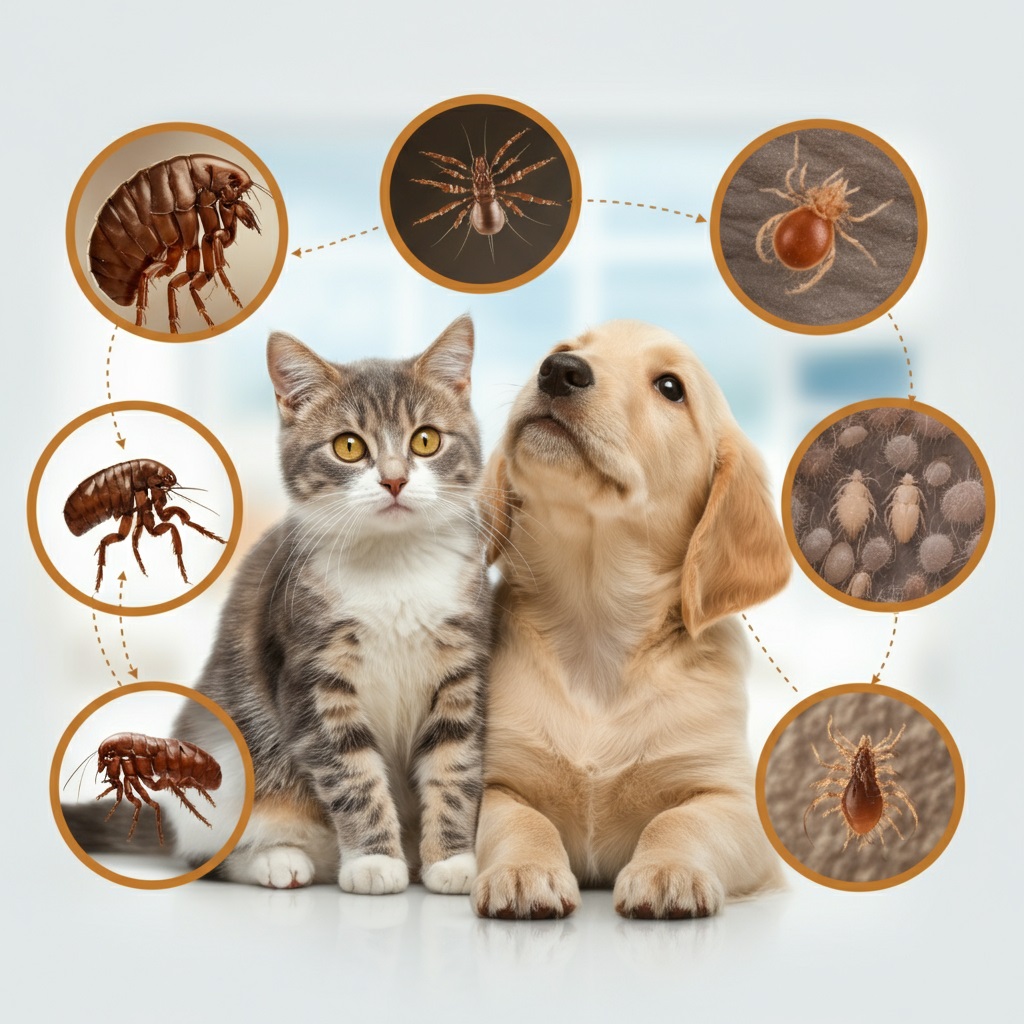
Your furry friend has been scratching more than usual, and you’re starting to wonder what’s going on. While occasional scratching is normal, persistent itching could signal unwelcome visitors: fleas or mites. These tiny parasites can make your pet’s life miserable and quickly spread throughout your home if left untreated.
The challenge lies in distinguishing between these two common culprits. Both fleas and mites cause intense itching, but they require different treatment approaches. Misidentifying the problem could lead to weeks of ineffective treatment while your pet continues to suffer.
Understanding the key differences between flea and mite infestations will help you take swift, targeted action. This guide will walk you through the telltale signs of each parasite, show you how to perform a proper examination, and explain when professional veterinary care becomes necessary.
Understanding Fleas: The Jumping Parasites
Fleas are wingless insects that survive by feeding on your pet’s blood. These remarkable jumpers can leap up to 150 times their body length, making them incredibly efficient at moving between hosts and spreading throughout your home.
Adult fleas measure about 1-3 millimeters in length and appear dark brown or reddish-brown in color. Their flattened bodies allow them to move easily through fur, while their powerful hind legs enable those impressive jumps that help them escape detection.
The flea lifecycle plays a crucial role in infestations. Adult fleas represent only about 5% of the total flea population in your home. The remaining 95% consists of eggs, larvae, and pupae hiding in carpets, upholstery, and cracks between floorboards. This explains why flea problems can persist even after treating your pet.
Common Signs of Flea Infestation
Excessive Scratching and Biting
Pets with fleas exhibit intense, frequent scratching, particularly around the base of the tail, behind the ears, and on the belly. You might notice your pet biting at their fur or licking certain areas obsessively.
Visible Fleas
Adult fleas appear as small, dark specks moving quickly through your pet’s fur. They’re most easily spotted on areas with thinner fur, such as the belly, inner thighs, and armpits.
Flea Dirt
Flea feces, commonly called “flea dirt,” looks like small black or dark brown specks scattered throughout your pet’s coat. To confirm it’s flea dirt rather than regular dirt, place the specks on a damp white paper towel. Flea dirt will turn reddish-brown as the dried blood dissolves.
Red, Irritated Skin
Flea bites create small, red bumps on your pet’s skin. Heavy infestations can lead to widespread irritation, hot spots, and secondary bacterial infections from excessive scratching.
Hair Loss
Constant scratching and biting can result in patchy hair loss, particularly in areas where fleas concentrate. This hair loss often appears irregular and may be accompanied by scabs or open wounds.
Understanding Mites: The Microscopic Menace
Mites are microscopic arachnids (related to spiders) that burrow into or live on your pet’s skin. Unlike fleas, most mites are too small to see with the naked eye, making diagnosis more challenging for pet owners.
Several types of mites affect pets, each causing distinct symptoms and requiring specific treatments. The most common varieties include sarcoptic mites (causing scabies), demodectic mites, ear mites, and cheyletiella mites (walking dandruff).
Mite infestations often develop more gradually than flea problems. While fleas jump onto pets from the environment, mites typically spread through direct contact with infected animals or contaminated bedding.
Types of Mites and Their Symptoms
Sarcoptic Mites (Scabies)
These highly contagious mites burrow into the skin, causing intense itching that worsens at night. Affected areas typically include the ears, elbows, hocks, and belly. The skin develops a crusty appearance, and hair loss occurs in irregular patches.
Demodectic Mites
These mites live in hair follicles and are often present in small numbers on healthy pets. Problems arise when the immune system becomes compromised, allowing mite populations to explode. Symptoms include patchy hair loss around the eyes and mouth, with skin that appears red and scaly.
Ear Mites
These mites specifically target the ear canal, causing intense itching and head shaking. Affected ears produce a dark, coffee-ground-like discharge with a distinctive musty odor. Pets may scratch their ears until they bleed.
Cheyletiella (Walking Dandruff)
These larger mites are sometimes visible as moving white specks on the pet’s coat. They cause excessive dandruff, mild itching, and skin scaling, particularly along the back and neck.
Key Differences Between Fleas and Mites
Understanding the distinctions between these parasites helps you identify the problem correctly and choose appropriate treatment.
Visibility and Detection
Fleas are large enough to spot with the naked eye, especially on light-colored pets or when examining areas with sparse fur. They move quickly and may jump when disturbed.
Most mites remain invisible without magnification. Instead of seeing the parasites themselves, you’ll notice their effects: unusual scratching patterns, specific types of skin damage, or characteristic discharge in the ears.
Scratching Patterns and Behavior
Flea-infested pets scratch frequently throughout the day, with particular attention to the lower back, tail base, and hindquarters. The scratching appears frantic and may be accompanied by sudden movements as if something is crawling on them.
Mite-related itching often follows different patterns. Sarcoptic mites cause nighttime scratching that intensifies when the pet is warm. Ear mites trigger head shaking and ear scratching specifically. Demodectic mites may cause minimal itching in early stages.
Continues after advertising
Location of Symptoms
Fleas prefer certain areas of your pet’s body but can be found anywhere. Common hotspots include the base of the tail, belly, inner thighs, and areas where the pet has difficulty reaching.
Different mite species target specific locations. Sarcoptic mites favor areas with thin skin, demodectic mites concentrate around the face, and ear mites remain confined to the ear canal.
Seasonal Patterns
Flea activity typically peaks during warm, humid months when conditions favor reproduction. However, indoor heating allows fleas to remain active year-round in many climates.
Mite problems can occur at any time but may worsen during stress periods or when pets have compromised immune systems. Some mites, like cheyletiella, may be more common in certain seasons or environments.
How to Examine Your Pet for Parasites
Conducting regular examinations helps catch infestations early when treatment is most effective. Set aside time weekly for a thorough check, especially during peak parasite season.
Flea Detection Techniques
Visual Inspection
Work through your pet’s fur systematically, starting from the head and moving toward the tail. Pay special attention to the base of the tail, where fleas often congregate. Use your fingers to part the fur and look for moving dark specks.
The Flea Comb Test
Run a fine-toothed flea comb through your pet’s coat, focusing on areas where fleas prefer to hide. After each pass, examine the comb for fleas or flea dirt. Dip the comb in soapy water to trap any fleas you find.
The White Towel Test
Have your pet stand on a white towel or sheet while you brush or comb them. Adult fleas and flea dirt will fall onto the light surface, making them easier to spot.
The Paper Towel Test
Collect any black specks from your pet’s coat and place them on a damp white paper towel. Genuine flea dirt will dissolve and create reddish-brown stains, confirming the presence of fleas.
Mite Detection Methods
Since most mites are microscopic, detection relies primarily on recognizing symptoms and affected areas.
Skin Examination
Look for unusual skin changes, including redness, scaling, crusty patches, or areas of hair loss. Note the pattern and location of these changes, as different mites create characteristic signatures.
Ear Inspection
Gently lift your pet’s ear flap and examine the ear canal. Look for dark, waxy discharge, unusual odors, or excessive scratching damage around the ears.
Behavioral Observation
Monitor your pet’s scratching habits. Note when scratching occurs most frequently, which areas receive the most attention, and whether certain activities or times of day trigger more intense itching.
When to Consult a Veterinarian
While some parasite problems can be managed at home, professional veterinary care becomes essential in certain situations.
Diagnostic Testing
Veterinarians can perform specific tests to confirm parasites and identify exact species. Skin scrapings examined under a microscope reveal mites that remain invisible to pet owners. Fungal cultures help rule out other conditions that mimic parasite symptoms.
Severe Infestations
Heavy parasite loads require prescription medications and professional monitoring. Secondary bacterial infections may develop from excessive scratching, requiring antibiotic treatment alongside parasite control.
Treatment Failure
If over-the-counter treatments fail to resolve the problem within a reasonable timeframe, veterinary intervention becomes necessary. Resistance to certain medications or misdiagnosis of the parasite type can lead to treatment failure.
Compromised Pets
Young, elderly, or immunocompromised pets need professional care when dealing with parasites. These animals are more susceptible to severe infestations and may require modified treatment protocols.
Prevention Strategies
Preventing parasite infestations is more effective and less stressful than treating established problems.
Environmental Management
Regular vacuuming removes flea eggs, larvae, and pupae from carpets and upholstery. Wash pet bedding weekly in hot water to eliminate any developing parasites. Maintain proper humidity levels, as both fleas and some mites thrive in humid conditions.
Regular Grooming
Weekly brushing and combing help detect parasites early while removing loose fur where parasites might hide. Regular baths with appropriate shampoos can help prevent infestations, though over-bathing can strip natural oils that protect the skin.
Preventive Medications
Many monthly flea and tick preventives also protect against certain types of mites. Consult your veterinarian about the best preventive program for your pet’s lifestyle and risk factors.
Read More👉 Most Popular Dog & Cat Names in 2025
Taking Action for Your Pet’s Comfort
Identifying whether your pet has fleas or mites marks the first step toward restoring their comfort and health. Both parasites cause significant discomfort, but accurate identification ensures you choose the most effective treatment approach.
Remember that parasite problems rarely resolve on their own. Early intervention prevents minor infestations from becoming major household problems that take months to eliminate. If you’re unsure about what’s causing your pet’s symptoms, don’t hesitate to seek professional veterinary advice.
Your pet depends on you to recognize when something isn’t right and take appropriate action. With the knowledge from this guide, you’re better equipped to identify these common parasites and help your furry friend return to a comfortable, itch-free life.



